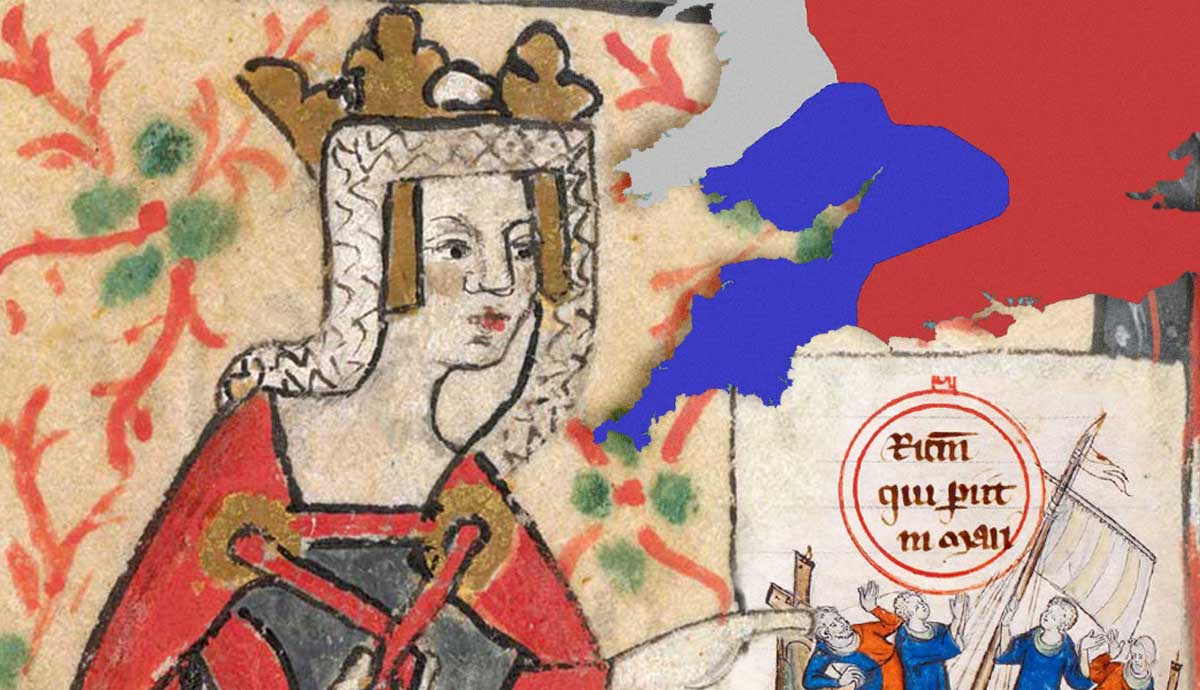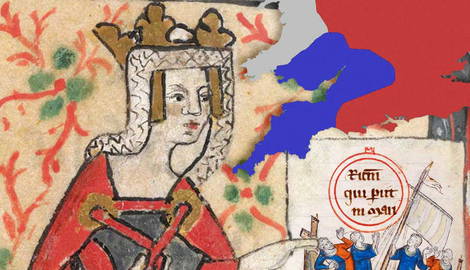
From her origins in England, to her marriage in Germany, to her campaigns in France, Empress Matilda truly was a European in every sense of the word. But more than that, she was active in the political scene during her lifetime: she married a Roman Emperor, gave birth to the first Plantagenet king of England, and joined Scotland with England, making Matilda a well-known character in the High Middle Ages.
1. Empress Matilda’s Marriage to Henry V, Holy Roman Emperor

Before we dive into Matilda’s marriage, it is worth looking at her family tree to get a sense of her lineage and where she came from. She was the daughter of Henry I of England (r. 1100-35), and interestingly only one of his two legitimate children — he had 24 illegitimate children! Matilda’s mother was Matilda of Scotland, who was a daughter of King Malcolm III of Scotland (r. 1058-93). Henry was also the youngest son of William the Conqueror, the first Norman King of England (r. 1066-87), so had claims to an empire stretching from France to Wales. Thanks to his marriage to Matilda of Scotland, his territories also included Scotland.
Matilda was born around the 7th of February 1102, and although very little is known of her early life, we do know that she was betrothed to be married at a very young age, which was not an uncommon practice in the Middle Ages. In either late 1108 or early 1109, King Henry V of Germany (r. 1099-1125) sent envoys to England suggesting that Matilda should marry him. Naturally, to Henry I, this was an attractive offer. Matilda would be marrying into one of the most powerful families in Europe, and Henry would also receive a dowry of 10,000 marks — enough to fund his expedition to Rome to be crowned Holy Roman Emperor.

By February 1110, Matilda had been shipped off to Germany to marry Henry V. Matilda was eight years old, and Henry was in his twenties. Due to their considerable age gap, Matilda was placed into the care of Bruno, the Archbishop of Trier, who was tasked with educating her in German culture, government and etiquette. By 1114, Matilda was deemed ready to marry Henry, and their ceremony took place in Worms, amid huge celebrations.
During her marriage to Henry, Empress Matilda gained key political experience, including through Henry’s excommunication by Pope Paschal II. When Henry and Matilda marched an army to Rome in 1117, Paschal fled, and the monarchs were crowned by the anti-pope (Maurice Bourdin) who went under the papal name Gregory VIII. Matilda used these ceremonies to cement her title as Empress of the Holy Roman Empire.
Maurice Bourdin had been excommunicated himself and imprisoned for life by Pope Callixtus II in later years, but Matilda insisted that she had been crowned as Holy Roman Empress, and used this title until her death, seemingly with little opposition or questioning.
Her marriage to Henry V certainly helped her to come out of her shell and gain real political experience at the highest courts in Europe. However, their marriage ended abruptly in 1125, when Henry died of cancer on 23 May 1125. Although not a long marriage by any stretch, it still served its purpose of throwing Matilda into the spotlight of European high politics, and it also laid the foundation for her later career.
2. The White Ship Disaster

On 25 November 1120, a ship containing noblemen and women set sail from Normandy to England. However, it never reached England — it struck a rock outside of Normandy and sunk, leaving only one passenger alive: a butcher from Rouen. The White Ship likely lost control due to excessive drinking on behalf of the crew and passengers, and also stormy and wintry conditions over the freezing waters of the English Channel.
On the ship was Henry I’s son and heir, William, who was also Empress Matilda’s brother. This sent a shockwave throughout English politics and there was a succession crisis: who was going to succeed Henry I as King of England?
Since the Norman invasion of England under William the Conqueror in 1066, there had not been a peaceful concession: two of William’s sons (William and Robert) fought a war over who was to succeed — William won, so he took the throne. Similarly, Henry I only managed to stake his claim because he had acquired Normandy by force.
Henry decided to take matters into his own hands and try to father another legitimate heir (a woman succeeding her father was just about out of the question). He and his new wife Adeliza of Louvain did not conceive any children, so his dynasty looked at risk of collapsing.
Henry eventually warmed to the idea of Empress Matilda succeeding him, if he could not father any more children. The White Ship disaster was more than just a shipwreck off the coast of France — it was a shipwreck for European high politics, with a civil war looming on the horizon: and Matilda was at the forefront of it.
3. Marriage to Geoffrey of Anjou

Following Henry V’s death, Henry I began to look for a new husband for his daughter. He eventually settled on Geoffrey of Anjou (also known as Geoffrey Plantagenet), the son of Fulk V of Anjou, who was also the King of Jerusalem. He chose this marriage tactically, so that he could have security in southern France.
However, Empress Matilda was 25 and Geoffrey was 13, and the pair did not particularly like each other. Nevertheless, they were married on 17 June 1128. Despite their marriage getting off to a rocky start, Matilda gave birth to their first child in March 1133 — the future King Henry II of England. Their second son, Geoffrey, was born a year later.
This was so significant because it marked the beginning of the strain on Henry I’s and Matilda’s relationship. Geoffrey and Matilda felt that Henry I should give up his castles in Normandy, but Henry was fearful that his daughter and son-in-law would try to steal power from him while he was still alive. A rebellion broke out, and Empress Matilda and Geoffrey sided with the rebels. It was then that Henry I died. And what bad timing — he had not laid out any official plans for his succession: civil war was about to break out.
4. Civil War

Upon the announcement of Henry I’s death, Empress Matilda was in Anjou and pregnant with her third son, William. However, news had also reached Stephen of Blois, Matilda’s cousin and one of Henry’s rumored choices for a successor. Stephen reached London by 8 December 1135, a week after Henry I’s death, and was crowned as King Stephen of England on 26 December that same year.
Matilda remained in France for the next three years, biding her time and garnering support for her cause to claim the throne. Meanwhile, Stephen had to put down rebellions in southern Wales, and come to a compromise with King David I of Scotland (Matilda’s uncle) for his raids into northern England.
By late summer 1139, Empress Matilda begun her invasion. Her fleet landed in Arundel and marched up to Gloucester before meeting with Stephen’s forces. Stephen imprisoned Matilda, sending her back to Arundel castle. The reasons why he did this are unclear, although one is that it was thought that Arundel was impregnable, and that he saw Robert of Gloucester (one of Henry I’s illegitimate sons) as more of a threat than Matilda.
However, at the start of 1141, the tide turned in the favor of Empress Matilda. Ranulf of Chester had fallen out with Stephen, and as a result, Stephen placed his castle in Lincoln under siege. This led to the Battle of Lincoln, on 7 February 1141. During the ensuing battle, Matilda’s forces captured Stephen, and imprisoned and effectively deposed him.

In the aftermath, Empress Matilda was proclaimed “Lady of England and Normandy”, as a precursor to her coronation. However, Stephen’s wife, Queen Matilda, had expressed her disgust at the imprisonment of her husband, the king. The city of London rose up in revolt, and Matilda and her forces withdrew quickly, finding safety in Oxford.
Eventually, in 1142, Matilda was surrounded by Stephen’s forces in Oxford, and she was kept as a prisoner at Oxford Castle. Stephen was not prepared to let Matilda live like he had done at Arundel Castle, and decided to start a siege, in order to either starve her to death or starve her into submission.
What followed next is one of history’s finest tales of escape. Just before Christmas in 1142, one dark night, Matilda snuck out of the castle with a retinue of knights, allegedly camouflaged by covering herself with a white sheet. They crossed the frozen River Isis, and escaped to Wallingford, leaving the castle garrison to surrender the following day.
Matilda returned to France for safety, and by the late 1140s, the majority of the fighting in the civil war had stopped, leaving a stubborn stalemate between the sides. But this did not mean that Matilda stopped orchestrating her side of the conflict — she was the brains behind the plans to put her son, Henry, on the English throne to end the Anarchy once and for all.
5. Matilda Puts Her Son on the English Throne

Henry had a claim to the English throne, and a more direct claim than that of Stephen. Henry was the grandson of Henry I of England, his direct issue through his daughter Empress Matilda, whereas Stephen was Henry’s nephew, and thus not his direct issue.
In 1151, Geoffrey died, and Henry claimed the Plantagenet lands as his own, from which he could build a support base. Henry returned to England in 1153, but, both sides weary from almost 20 years of war, were unwilling to fight. With the help of the Church, the two sides brokered a peace, known as the Treaty of Wallingford.
The terms of this treaty meant that Henry recognized Stephen as King of England, but that upon Stephen’s death, Henry would become his adopted son and successor. Stephen died the following year, and Henry Plantagenet was crowned as King Henry II of England. He would reign until his death in 1189.










